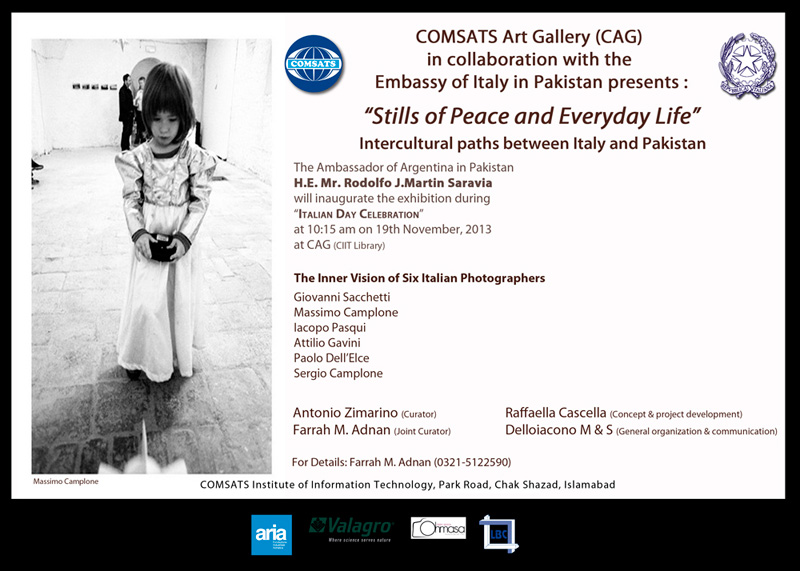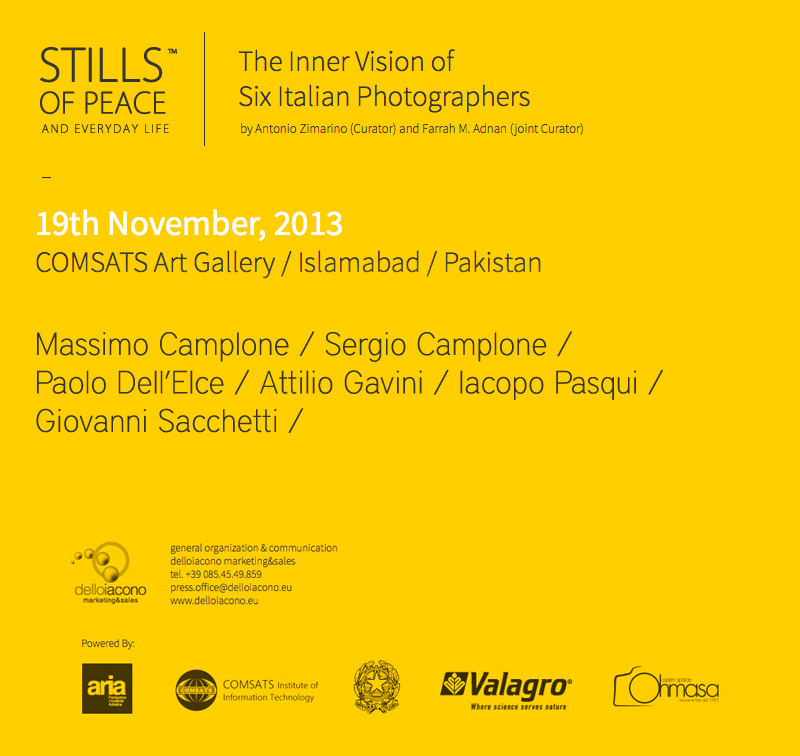BACK >>
ISLAMABAD, PAKISTAN
The Inner Vision of Six Italian Photographers
by Antonio Zimarino (Curator) and Farrah M. Adnan (joint Curator)
Giovanni Sacchetti / Massimo Camplone / Sergio Camplone /
Paolo Dell'Elce / Attilio Gavini / Iacopo Pasqui /
19th november, 2013
COMSATS Art Gallery(CAG) Islamabad, Pakistan
in collaboration with the Embassy of Italy in Pakistan


The six photographers in this exhibition accompany us on a very interesting trip, in and through the environment and life of a part of Italy of our times. Unusual natural or urban landscapes, among traces of normal, simple lives, among people who skirt other people every day. The artist's eye captures snippets and nooks of views that are frozen in the moment of the shutter click and let us see inside and through the appearance of the newspaper.
A reflection, a colour, a line, a perspective, a light or a shadow, a gesture, an overlapping of many of these things that allows them to stop and try to catch your eye and that of others, as if seeking to save something from passing time, something that will not die and is worth keeping and remembering. Whilst in each of these images we perceive a great mastery of the technical method, and a profound knowledge of the artistic languages of contemporary photography (with special attention to an Italian koiné), it is also true that these images show a kind of profound reflection that each of the artists, in their own way, has made on the reality around us.
Nevertheless, they share a common factor that transcends the mere ability to record anything that happens; something that – more than technique – leads them to conceive photography in the creative logic of contemporary art. They share (as do the most alert and profound contemporary artists) the anxiety to search out and reveal what Eugenio Montale (a great Italian poet of the twentieth century) called: "the ring that does not withstand", the fragile link in a chain of facts that is always too logical, events and situations of human existence apparently always the same and unavoidably predictable.
That this is also their own research is understood by the often unconventional choice of the visual field to be captured, the manner of cutting and framing the image, the careful use of colour and contrast, from the "analytical" stance in very clear, chilling lights, by the careful choice of the relationship between shape and depth. Scrolling and reflecting the images of the artists in this preview of the exhibition to be held in March 2014, I saw them looking for meanings, explanations, poetry, stories, greatness, insights, and so on. Basically, they appeared to me like tireless seekers of moments of beauty, definitions and awareness.
Their photographs are moments in which the eye, and with it human interiority, tries to shake off existential triviality, non-sense, starting to rationalize and then imagining or contemplating what can still be said by the space and the natural and cultural Nature to which we belong. An image can become a story to discover and imagine, or it can be the clear evidence of an optical and mental space we will cover in eternity. An image can give the impression of the fleeting moment or the clear evidence of a reality whose visual definition can be analyzed and, why not, understood, considered, explored.
Every day, we encounter many stories that stand before us and for them these images are there to ask us if we are really able to look within and beyond things? Are we really able to see what is hidden in fleeting impressions? Are we able to grasp the depth that the seemingly trivial moment can offer us? Photography, basically, becomes eternal time and only in this way can it give us back inner time, which we need to build a meaning inside us. But "constructing meanings" also means building a "culture" and "Culture", and the recognizable representation of our choices, our approach to life, our relationship with the world, the landscape, people, and the daily routine we journey.
Perhaps the Italy troubled by the economic and political crises of our time needs this awareness, an understanding that the world, the space, the relationships we intend to rebuild and, above all, to understand become precisely the world as we tend to illustrate it to ourselves. If we look at it to use it, it will be used, if we look at it to exploit it, it will be exploited, but if we look at it to understand it, it can be understood and if we look at it to rebuild and love it, it will be loved and rebuilt.
The photographer or the artist's eye, mind and idea of the world reflect the world and the detail they see. Basically we ask the visual arts for this "deeply human" aspect: to open in reality a portion of thought, a piece of imagination, a place where we have time enough to reflect, to slow down the frenzy, to rediscover the essential.
It is the world that came to mind when I saw these photographs, which are the result of ways of thinking and seeing reality, particular approaches to the world and relationships, different for each of the artists but who share this engagement in the meditative and existential "depth". This dimension of careful research into reality and reflection in the life and times of each day, as well as into settings, light and viewpoints enables these images to push to an inner reflection that sometimes leads us to a sort of contemplative peace that can generate a profound contribution to humanity.
After all, this is precisely why they are expressions of "contemporary art": because they try to make us read things differently and deeper than how they may appear, not only to record them but also to try to interpret them, to understand them, and to help us understand.
In his own way, each artist in this small review has told us there is something always worth looking at and discovering in what surrounds us. It is always worth paying attention to people, to nature, to those little – apparently banal – things we encounter every day, because these are the things that can highlight the weaving of our thoughts and inner lives, why our sensitivity to these things makes people able to understand other people, and able to think of different relationships that are more authentically and positively "human".